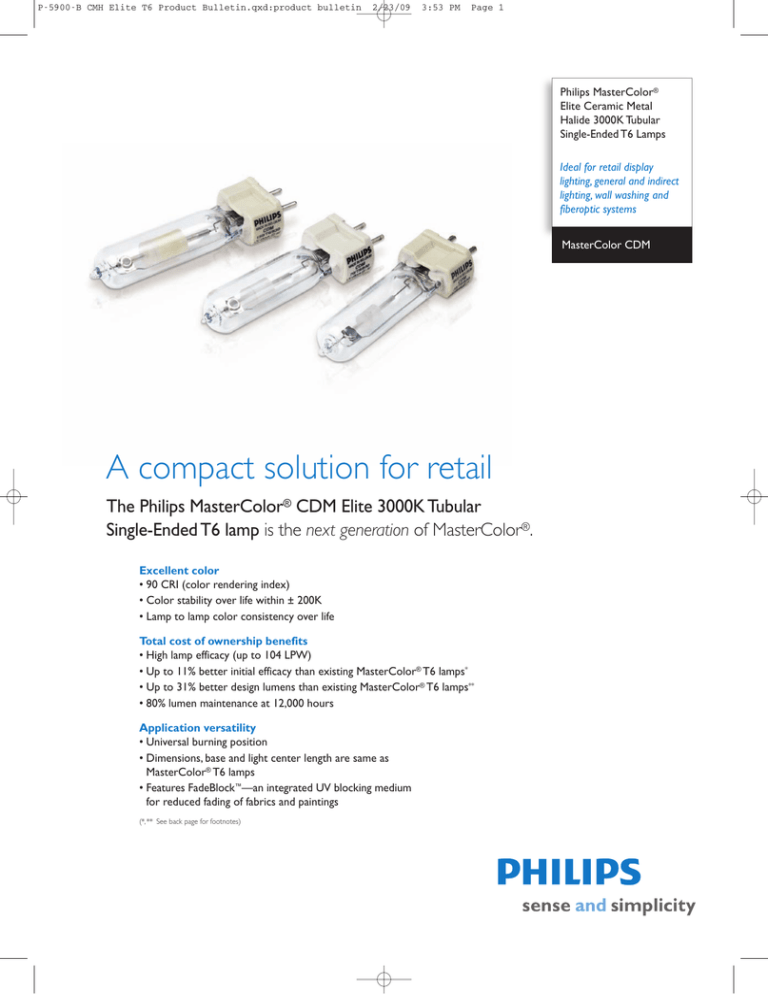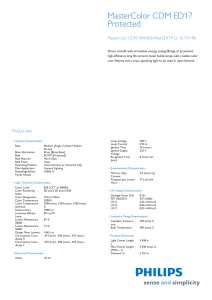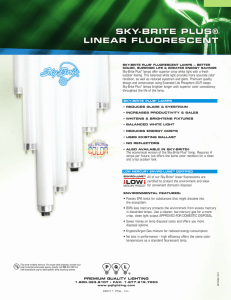
P-5900-B CMH Elite T6 Product Bulletin.qxd:product bulletin
2/23/09
3:53 PM
Page 1
Philips MasterColor®
Elite Ceramic Metal
Halide 3000K Tubular
Single-Ended T6 Lamps
Ideal for retail display
lighting, general and indirect
lighting, wall washing and
fiberoptic systems
MasterColor CDM
A compact solution for retail
The Philips MasterColor® CDM Elite 3000K Tubular
Single-Ended T6 lamp is the next generation of MasterColor®.
Excellent color
• 90 CRI (color rendering index)
• Color stability over life within ± 200K
• Lamp to lamp color consistency over life
Total cost of ownership benefits
• High lamp efficacy (up to 104 LPW)
• Up to 11% better initial efficacy than existing MasterColor® T6 lamps*
• Up to 31% better design lumens than existing MasterColor® T6 lamps**
• 80% lumen maintenance at 12,000 hours
Application versatility
• Universal burning position
• Dimensions, base and light center length are same as
MasterColor® T6 lamps
• Features FadeBlock™—an integrated UV blocking medium
for reduced fading of fabrics and paintings
(*,** See back page for footnotes)
P-5900-B CMH Elite T6 Product Bulletin.qxd:product bulletin
2/23/09
3:53 PM
Philips MasterColor® Elite Ceramic Metal Halide 3000K Tubular
Single-Ended T6 Lamps
MasterColor CDM Elite T6
Ordering Data (Subject to change without notice)
Product
Number
40483-0
14836-1
40495-3
Pkg.
Ordering Code
Qty.
CDM Elite35/T6/930 12
CDM Elite70/T6/930 12
CDM Elite150/T6930 12
Nom.
Watt.
39
70
150
Approx.
Initial
Lumens1
3500
7300
15,000
Approx.
Mean
Lumens2
3150
6500
13,500
CRI
90
90
90
Electrical and Technical Data
Physical Characteristics
Lamp Operating Volt. (rms)(Nom.)3 –––––––85 (39W)
–––––––––––––––––––––––––––––––––––86 (70W)
––––––––––––––––––––––––––––––––––88 (150W)
Initial Lamp Volt. Range (rms)4 ––––––––––––––80-100
Lamp Operating
Current (Amps) Nominal (rms) ––––––––0.53 (39W)
––––––––––––––––––––––––––––––––––0.98 (70W)
–––––––––––––––––––––––––––––––––1.65 (150W)
Lamp Current Crest Factor (Maximum)–––––––––1.8
Warm-up to 80% Full Brightness –––––––––2 minutes
Restrike Time for Hot Lamps–––––––––– 4-8 minutes
Ballast Open Circuit Voltage ––––209 RMS Min. (39W)
–––––––––––––––––––––198 RMS Min. (70W, 150W)
Pulse Peak Volts ––––––––––––––––––––––3000-4000
Pulse Width @ 90% Peak –––––2 Micro Sec. Minimum
Pulse Repetition Rate (Minimum)5 –––2 per Half Cycle
Minimum Operating Temp. –––––––––– -30ºC (-22ºF)
Bulb Size –––––––––––––––––––––––––––––––––T-6
Bulb Finish ––––––––––––––––––––––––––––––Clear
Base ––––––––––––––––––––––––––––––G-12 Bi-Pin
Max. Overall Length (MOL) –––––––––––––––––315⁄16"
Light Center Length (LCL) ––––––––––––––––––27⁄32''
Arc Length –––––––––––––––––0.17" (4.3mm)(39W)
–––––––––––––––––––––––––0.23'' (5.75mm)(70W)
–––––––––––––––––––––––––0.33" (8.5mm) (150W)
Max. Bulb Temp. –––––––––––––––––––500ºC (932ºF)
Max. Base Temp.–––––––––––––––––––250ºC (482ºF)
Arc Tube Material –––––––––Poly Crystalline Alumina
Max Bulb to Base Eccentricity –––––––––––––––––3º
Max.Arc Tube to Base Eccentricity ––––––––––––––3º
Representative Spectral Power
®
Distribution of MasterColor 3000K Lamps
100
Relative Energy
ANSI
Ballast
Code
C130/E
C139/E
C142/E
Operating Characteristics
Rated Average Life, Hours.6 ––––––––––––––––12,000
Correlated Color Temp. (CCT)2 ––––––––––––3000K
CIE Chromaticity Approx.2 –––––x-.432 y-.396 (39W)
–––––––––––––––––––––––––––x-.434 y-.395 (70W)
––––––––––––––––––––––––––x-.428 y-.395 (150W)
Efficacy (lpw)–––––––––––––––––––––––––90 (39W)
––––––––––––––––––––––––––––––––––104 (70W)
–––––––––––––––––––––––––––––––––100 (150W)
80
Operating Position
60
Universal
Enclosed luminaires only.
NOTE: Use on thermally protected
electronic ballast only.
40
20
0
400
450
500
550
600
650
700
Wavelength — nanometers
1) Measured at 100 hrs. life. Approximate lumen values listed are for vertical operation of the lamp.
2) Approximate lumen output at 40% of lamp rated average life.
3) Measured at rated lamp watts on a linear reactor. LPW does not include ballast losses.
4) Measured with the lamp operating at rated watts.
5) Option-Pulse Width @ 90% Peak, 1 micro second minimum with 2 pulses per half cycle.
6) Rated average life is the life obtained, on the average, from large representative groups of lamps in laboratory tests under controlled conditions at 10 or more operating hours per start. It is based on survival of at least 50% of the lamps and allows for individual lamps or
groups of lamps to vary considerably from the average.
Footnotes from front page:
* Based on a MasterColor Elite 3000K Tubular Single-Ended T6 70 W lamp with 7,300 initial lumens
vs. a CDM T6 70W lamp with 6,600 initial lumens.
** Based on a MasterColor Elite 3000K Tubular Single-Ended T6 70 W lamp with 6,500 design lumens
vs. a CDM T6 70W lamp with 4,950 design lumens.
© 2009 Philips Lighting Company. All rights reserved.
Printed in USA 2/09
P-5900-B
www. philips.com
Page 2
WARNINGS, CAUTIONS AND OPERATING INSTRUCTIONS
for MasterColor® Ceramic Metal Halide Lamps: Single-Ended
CDM-T G12 and CDM-TC G8.5 (Universal); except CDM Elite
TC/35/930 and CDM Elite T6/35/930 (Vertical Position ± 60º);
Double-Ended CDM-TD RX7 (Horizontal ± 45º, Enclosed
Fixtures Only)
“WARNING: These lamps can cause serious skin burn and eye
inflammation from short wave ultraviolet radiation if outer envelope
of the lamp is broken or punctured. Do not use where people will remain
for more than a few minutes unless adequate shielding or other safety
precautions are used. Certain lamps that will automatically extinguish when
the outer envelope is broken or punctured are commercially available.”
This lamp complies with FDA radiation performance standard 21 CFR
subchapter J. (USA:21CFR 1040.30 Canada:SOR/DORS/80-381)
If the outer bulb is broken or punctured, turn off at once and
replace the lamp to avoid possible injury from hazardous short
wave ultraviolet radiation. Do not scratch the outer bulb or
subject it to pressure as this could cause the outer bulb to crack
or shatter.A partial vacuum in the outer bulb may cause glass
to fly if the envelope is struck.
WARNING: The arc-tube of metal halide lamps are designed to operate
under high pressure and at temperatures up to 1000ºC and can unexpectedly
rupture due to internal or external factors such as a ballast failure or
misapplication If the arc-tube ruptures for any reason, the outer bulb may
break and pieces of extremely hot glass might be discharged into the
surrounding environment. If such a rupture were to happen, THERE IS A
RISK OF PERSONAL INJURY, PROPERTY DAMAGE, BURNS
AND FIRE.
Certain lamps that will retain all the glass particles should inner
arc-tube rupture occur are commercially available from Philips
Lighting Company.
RELAMP FIXTURES AT OR BEFORE THE END OF RATED
LIFE.Allowing lamps to operate until they fail is not advised and
may increase the possibility of inner arc tube rupture.
This lamp contains an arc tube with a filling gas containing less
than 10 nCi of Kr-85 and is distributed by Philips Lighting
Company, a division of Philips Electronics North America
Corporation, Somerset, New Jersey, 08875.
CAUTION: TO REDUCE THE RISK OF PERSONAL INJURY, PROPERTY
DAMAGE, BURNS AND FIRE RESULTING FROM AN ARC-TUBE
RUPTURE THE FOLLOWING LAMP OPERATING INSTRUCTIONS
MUST BE FOLLOWED:
LAMP OPERATING INSTRUCTIONS:
1. RELAMP FIXTURES AT OR BEFORE THE END OF RATED LIFE.
Allowing lamps to operate until they fail is not advised and may increase
the possibility of inner arc tube rupture.
2. Use only in fully enclosed fixtures capable of withstanding particles of
glass having temperatures up to 1000ºC. Lens/diffuser material must be
heat resistant. Consult fixture manufacturer regarding the suitability of the
fixture for this lamp.
3. Do not operate a fixture with a missing or broken lens/diffuser.
4. Operate lamp only within specified limits of operating position.
5. Before lamp installation/replacement, shut power off and allow lamp and
fixture to cool to avoid electrical shock and potential burn hazards.
6. Use only auxiliary equipment meeting Philips and/or ANSI standards.
Use within voltage limits recommended by ballast manufacturer.
A. Operate lamp only within specified limits of operation.
B. For total supply load refer to ballast manufacturers electrical data.
C. Operate CDM-T6 (G12 base) lamps only on thermally
protected ballasts.
D. Operate CDM-TC lamps (G8.5 base), CDM-T6 Elite
lamps, and CDM-T6 39W/842 lamps only on thermally
protected electronic ballasts.
7. Periodically inspect the outer envelope. Replace any lamps that show
scratches, cracks or damage.
8. If a lamp bulb support is used, be sure to insulate the support
electrically to avoid possible decomposition of the bulb glass.
9. Protect lamp base, socket and wiring against moisture, corrosive
atmospheres and excessive heat.
10. Time should be allowed for lamps to stabilize in color when turned on
for the first time.This may require several hours of operation, with more
than one start. Lamp color is also subject to change under conditions
of excess vibration or shock and color appearance may vary between
individual lamps.
11. Lamps may require 4 to 8 minutes to re-light if there is a
power interruption.
12. Take care in handling and disposing of lamps. If an arc tube is broken,
avoid skin contact with any of the contents or fragments.
R
Philips Lighting Company
200 Franklin Square Drive
P.O. Box 6800
Somerset, NJ 08875-6800
1-800-555-0050
Philips Lighting
281 Hillmount Road
Markham, Ontario
Canada L6C 2S3
1-800-555-0050
A Division of Philips Electronics North America Corporation
A Division of Philips Electronics Ltd.



